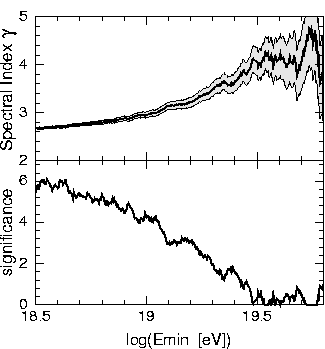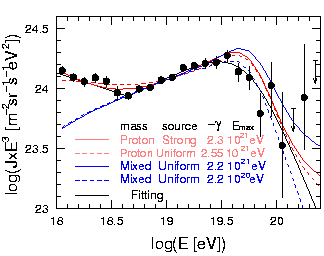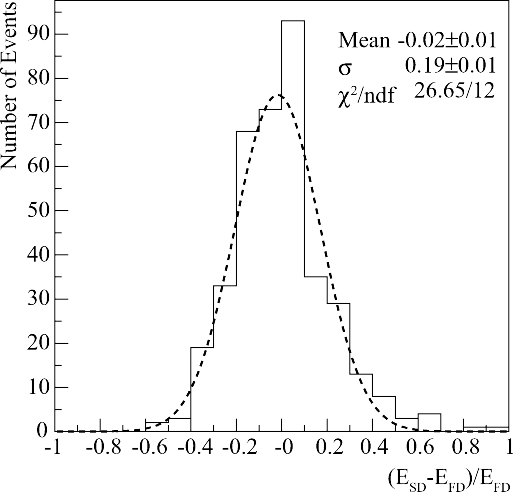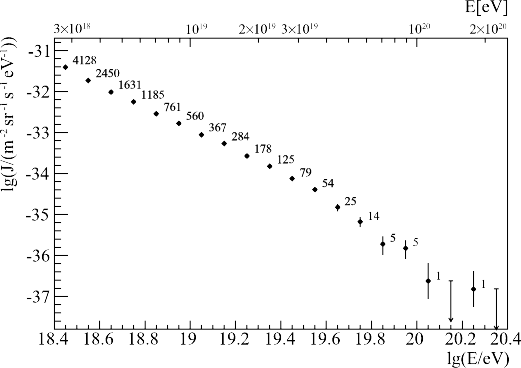


The cosmic ray energy spectra measured by the Pierre Auger Collaboration are shown on this web page. The data are from papers submitted to the ICRC07 conference. The differential cosmic ray flux J = dN/(dA dΩ dt dE) is expressed in units of [m-2s-1eV-1].
Click on thumbnails to get larger image
 |
| Figure 1: Integral number of events vs cos2 θ for
the indicated minimum value of S(1000). Using the constant intensity method, the signal flux atmospheric attenuation curve may be derived from the non-flatness of these distributions. Link to eps file |
| * * * |
 |
| Figure 2: The derived signal attenuation curve, CIC(θ), fitted
with a quadratic function. Link to eps file |
| * * * |
 |
| Figure 3: Correlation between the measured fluorescence energy EFD and
the measured ground flux parameter S38° for the 387 hybrid events used in the fit.
The full line is the best fit to the data and provides the empirical calibration of the surface detector energy measurement. To avoid fitting biases, events below the
dashed line were not included in the fit. |
| * * * |
 |
| Figure 4: The energy resolution is measured as the fractional difference between the FD and
SD energy for the 387 selected hybrid events. Link to eps file |
| * * * |
 |
| Figure 5: Auger spectrum J
as a function of energy. Vertical error bars represent the
statistical uncertainty only.
The statistical and systematic uncertainties in the energy
scale are of the order of ≈ 6% and ≈ 22%, respectively. The individual systematic uncertainties in determining ESD sum up to 22%. The largest uncertainties are given by the absolute fluorescence yield (14%), the absolute calibration of the FD (9.5%) and the surface event reconstruction method (10%). The uncertainty due to the dependence of the fluorescence spectrum on pressure (1%), humidity (5%) and temperature (5%) are taken into account as well as the wavelength dependent response of the FD, the aerosol phase function, invisible energy and others, which are well below 4%. The spectrum shown is the raw spectrum, uncorrected for possible biases due to energy-dependent and/or primary-composition-dependent systematic effects. Link to eps file |
| * * * |
 |
| Figure 6: Fractional difference between the derived
spectrum and an assumed flux proportional to
E -2.6 as a function of energy. Link to eps file |
| log(E [eV]) | dN/ (dln(E) dA dΩ dt) |
-σ | +σ | Num. of events |
|---|---|---|---|---|
| 18.05 | 1.13e-12 | 7.68e-14 | 7.82e-14 | -- |
| 18.15 | 6.26e-13 | 4.52e-14 | 4.58e-14 | -- |
| 18.25 | 3.63e-13 | 2.96e-14 | 2.99e-14 | -- |
| 18.35 | 2.46e-13 | 2.14e-14 | 2.16e-14 | -- |
| 18.45 | 1.46e-13 | 1.47e-14 | 1.49e-14 | -- |
| 18.55 | 7.33e-14 | 9.42e-15 | 9.49e-15 | -- |
| 18.65 | 4.37e-14 | 1.07e-15 | 1.07e-15 | -- |
| 18.75 | 3.14e-14 | 9.04e-16 | 9.04e-16 | -- |
| 18.85 | 2.04e-14 | 7.27e-16 | 7.27e-16 | -- |
| 18.95 | 1.49e-14 | 6.22e-16 | 6.23e-16 | -- |
| 19.05 | 9.82e-15 | 5.01e-16 | 5.02e-16 | -- |
| 19.15 | 7.54e-15 | 4.42e-16 | 4.42e-16 | -- |
| 19.25 | 4.90e-15 | 3.43e-16 | 3.44e-16 | -- |
| 19.35 | 3.25e-15 | 2.95e-16 | 2.95e-16 | -- |
| 19.45 | 2.10e-15 | 2.33e-16 | 2.33e-16 | -- |
| 19.55 | 1.50e-15 | 1.65e-16 | 1.69e-16 | -- |
| 19.65 | 6.92e-16 | 1.12e-16 | 1.16e-16 | -- |
| 19.75 | 3.92e-16 | 8.32e-17 | 9.69e-17 | -- |
| 19.85 | 1.24e-16 | 4.39e-17 | 5.76e-17 | -- |
| 19.95 | 1.33e-16 | 5.98e-17 | 7.49e-17 | -- |
| 20.05 | 2.67e-17 | 1.68e-17 | 4.68e-17 | -- |
| 20.15 | 0.0 | 0.0 | 3.42e-17 | 0 |
| 20.25 | 2.67e-17 | 1.68e-17 | 4.68e-17 | -- |
| 20.35 | 0.0 | 0.0 | 3.42e-17 | 0 |
ASCII file for the combined spectrum
| log(E [eV]) | dN/ (dln(E) dA dΩ dt) |
-σ | +σ | Num. of events |
|---|---|---|---|---|
| 18.45 | 1.10e-13 | 1.71e-15 | 1.71e-15 | 4128 |
| 18.55 | 6.53e-14 | 1.32e-15 | 1.32e-15 | 2450 |
| 18.65 | 4.35e-14 | 1.08e-15 | 1.08e-15 | 1631 |
| 18.75 | 3.16e-14 | 9.17e-16 | 9.17e-16 | 1185 |
| 18.85 | 2.03e-14 | 7.35e-16 | 7.35e-16 | 761 |
| 18.95 | 1.49e-14 | 6.31e-16 | 6.31e-16 | 560 |
| 19.05 | 9.78e-15 | 5.10e-16 | 5.10e-16 | 367 |
| 19.15 | 7.57e-15 | 4.49e-16 | 4.49e-16 | 284 |
| 19.25 | 4.74e-15 | 3.55e-16 | 3.55e-16 | 178 |
| 19.35 | 3.33e-15 | 2.98e-16 | 2.98e-16 | 125 |
| 19.45 | 2.10e-15 | 2.37e-16 | 2.37e-16 | 79 |
| 19.55 | 1.44e-15 | 1.96e-16 | 1.96e-16 | 54 |
| 19.65 | 6.66e-16 | 1.33e-16 | 1.33e-16 | 25 |
| 19.75 | 3.73e-16 | 9.85e-17 | 1.15e-16 | 14 |
| 19.85 | 1.33e-16 | 5.98e-17 | 7.49e-17 | 5 |
| 19.95 | 1.33e-16 | 5.98e-17 | 7.49e-17 | 5 |
| 20.05 | 2.66e-17 | 1.68e-17 | 4.68e-17 | 1 |
| 20.15 | 0.0 | 0.0 | 3.41e-17 | 0 |
| 20.25 | 2.66e-17 | 1.68e-17 | 4.68e-17 | 1 |
| 20.35 | 0.0 | 0.0 | 3.41e-17 | 0 |
ASCII file for the SD spectrum
| log(E [eV]) | dN/ (dln(E) dA dΩ dt) |
-σ | +σ | Num. of events |
|---|---|---|---|---|
| 18.85 | 2.24e-14 | 1.43e-15 | 1.43e-15 | 246 |
| 18.95 | 1.40e-14 | 1.13e-15 | 1.13e-15 | 153 |
| 19.05 | 1.11e-14 | 1.01e-15 | 1.01e-15 | 122 |
| 19.15 | 7.11e-15 | 8.05e-16 | 8.05e-16 | 78 |
| 19.25 | 4.74e-15 | 6.58e-16 | 6.58e-16 | 52 |
| 19.35 | 2.64e-15 | 4.91e-16 | 4.91e-16 | 29 |
| 19.45 | 1.92e-15 | 4.18e-16 | 4.18e-16 | 21 |
| 19.55 | 1.64e-15 | 3.82e-16 | 4.40e-16 | 18 |
| 19.65 | 8.21e-16 | 2.43e-16 | 3.46e-16 | 9 |
| 19.75 | 4.56e-16 | 2.05e-16 | 2.56e-16 | 5 |
| 19.85 | 9.12e-17 | 5.75e-17 | 1.60e-16 | 1 |
ASCII file for the inclined spectrum
| log(E [eV]) | dN/ (dln(E) dA dΩ dt) |
-σ | +σ | Num. of events |
|---|---|---|---|---|
| 18.05 | 1.10e-12 | 7.56e-14 | 7.56e-14 | 245 |
| 18.15 | 6.11e-13 | 4.44e-14 | 4.44e-14 | 209 |
| 18.25 | 3.54e-13 | 2.90e-14 | 2.90e-14 | 160 |
| 18.35 | 2.40e-13 | 2.10e-14 | 2.10e-14 | 140 |
| 18.45 | 1.42e-13 | 1.44e-14 | 1.44e-14 | 102 |
| 18.55 | 7.15e-14 | 9.22e-15 | 9.22e-15 | 62 |
| 18.65 | 4.70e-14 | 6.87e-15 | 6.87e-15 | 48 |
| 18.75 | 2.54e-14 | 4.75e-15 | 4.75e-15 | 29 |
| 18.85 | 2.36e-14 | 4.35e-15 | 4.35e-15 | 30 |
| 18.95 | 1.22e-14 | 3.85e-15 | 4.77e-15 | 17 |
| 19.05 | 1.01e-14 | 3.26e-15 | 4.46e-15 | 15 |
| 19.15 | 6.36e-15 | 2.45e-15 | 3.58e-15 | 10 |
| 19.25 | 8.20e-15 | 2.87e-15 | 3.61e-15 | 14 |
| 19.35 | 1.50e-15 | 9.50e-16 | 1.80e-15 | 3 |
| 19.45 | 1.75e-15 | 1.11e-15 | 2.09e-15 | 3 |
| 19.55 | 1.82e-15 | 1.15e-15 | 1.85e-15 | 4 |
| 19.65 | 4.82e-16 | 3.98e-16 | 1.24e-15 | 1 |
| 19.75 | 0.0 | 0.0 | 8.56e-16 | 0 |
| 19.85 | 0.0 | 0.0 | 7.50e-16 | 0 |
| 19.95 | 0.0 | 0.0 | 8.92e-16 | 0 |